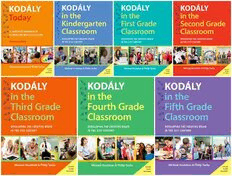
Kodály Today Handbook Series PDF
Preview Kodály Today Handbook Series
Kodály Today Kodály Today Handbook Series Micheál Houlahan and Philip Tacka Kodály Today: A Cognitive Approach to Elementary Music Education, second edition Kodály in the Kindergarten Classroom: Developing the Creative Brain in the 21st Century Kodály in the First Grade Classroom: Developing the Creative Brain in the 21st Century Kodály in the Second Grade Classroom: Developing the Creative Brain in the 21st Century Kodály in the Third Grade Classroom: Developing the Creative Brain in the 21st Century Kodály in the Fourth Grade Classroom: Developing the Creative Brain in the 21st Century Kodály in the Fifth Grade Classroom: Developing the Creative Brain in the 21st Century Kodály Today A Cognitive Approach to Elementary Music Education Second Edition Micheál Houlahan Philip Tacka 1 1 Oxford University Press is a department of the University of Oxford. It furthers the University’s objective of excellence in research, scholarship, and education by publishing worldwide. Oxford New York Auckland Cape Town Dar es Salaam Hong Kong Karachi Kuala Lumpur Madrid Melbourne Mexico City Nairobi New Delhi Shanghai Taipei Toronto With offices in Argentina Austria Brazil Chile Czech Republic France Greece Guatemala Hungary Italy Japan Poland Portugal Singapore South Korea Switzerland Thailand Turkey Ukraine Vietnam Oxford is a registered trademark of Oxford University Press in the UK and certain other countries. Published in the United States of America by Oxford University Press 198 Madison Avenue, New York, NY 10016 © Oxford University Press 2015 All rights reserved. No part of this publication may be reproduced, stored in a retrieval system, or transmitted, in any form or by any means, without the prior permission in writing of Oxford University Press, or as expressly permitted by law, by license, or under terms agreed with the appropriate reproduction rights organization. Inquiries concerning reproduction outside the scope of the above should be sent to the Rights Department, Oxford University Press, at the address above. You must not circulate this work in any other form and you must impose this same condition on any acquirer. Library of Congress Cataloging-in-Publication Data Houlahan, Micheál, author. Kodály today: a cognitive approach to elementary music education/by Micheál Houlahan and Philip Tacka.—2nd edition. pages cm Includes bibliographical references and index. ISBN 978–0–19–025501–5 (hardback)—ISBN 978–0–19–023577–2 (paperback) 1. School music—Instruction and study. 2. Cognitive learning. 3. Kodály, Zoltán, 1882-1967. I. Tacka, Philip, author. II. Title. MT1.H838 2015 372.87′dc23 2014032953 9 8 7 6 5 4 3 2 1 Printed in the United States of America on acid-free paper We are the music-makers, And we are the dreamers of dreams, Wandering by lone sea-breakers, And sitting by desolate streams; World-losers and world-forsakers, On whom the pale moon gleams: Yet we are the movers and shakers Of the world for ever, it seems. Ode, by Arthur O’Shaughnessy […] eratque tam turpe Musicam nescire quam litteras from De Musica, by Isidoris Hispalensis “Legyen A Zene Mindenkié” [Music should belong to everyone] Zoltán Kodály vii Contents Acknowledgments • xiii About the Companion Website • xv Introduction • 1 1 Building the Framework of a Music Curriculum Based on the Kodály Concept • 14 Zoltán Kodály: A Biographical Outline • 15 A Brief Examination of Zoltán Kodály’s Philosophy of Music Education • 18 The Kodály Method or Concept of Music Education • 27 Building the Framework of a Curriculum Based on the Multiple Dimensions of Music • 28 Music Philosophy Prompt Questions • 35 Linking a Music Curriculum Based on the Kodály Concept to the National Content Standards for Music Education • 37 The Kodály Concept and the Common Core Standards • 39 Lesson Planning • 40 Key Components of Lesson Plan Designs • 42 Discussion Questions • 47 Ongoing Assignment • 48 Connections to Grade Handbooks • 48 Bibliography • 48 2 Developing a Music Repertoire of Songs for the Elementary Music Classroom • 53 Folk Music in the Classroom • 54 Selecting Music for Classroom Use • 57 Creating an Alphabetized Song Repertoire List for Each Grade • 59 Analyzing Song Repertoire • 59 Performance and Notation of Folk Songs • 73 Lesson Planning • 73 Connections to Grade Handbooks • 87 Discussion Questions • 87 Ongoing Assignment • 87 Bibliography • 87 Contents 3 Developing Creative Expression in the Elementary Classroom viii Through Singing, Movement, and Playing Instruments • 99 Singing • 100 Singing in Tune with Relative Solmization • 110 Teaching Songs • 112 Introducing Songs Within a Lesson • 118 Singing Games and Movement Activities • 120 Developing Creative Movement and Improvisations in the Classroom • 131 Body Warm-ups and Creative Movement • 132 Instruments • 134 Lesson Planning • 138 Connections to Grade Handbooks • 145 Discussion Questions • 145 Ongoing Assignment • 146 Bibliography • 146 4 Teaching Tools and Techniques for Developing Audiation and Music Literacy Skills • 153 Teaching Tools for Developing Music Literacy Skills • 154 A Rhythmic and Melodic Sequence for Developing Music Literacy Skills • 162 The Relationship Between Musical Concepts and Elements • 164 Preparation, Presentation, and Practice of Musical Elements for Grades 1 Through 5 • 170 The Connection Between Teaching Basic Rhythmic and Melodic Patterns and Common Stylistic Characteristics of Folk Songs • 175 Lesson Planning • 176 Connections to Grade Handbooks • 184 Discussion Questions • 185 Ongoing Assignment • 185 Bibliography • 185 5 From Sound to Symbol: A Model of Learning and Instruction for Teaching Music Concepts, Elements, and Skills • 191 A New Learning Theory Model • 193 A Comparison of the Houlahan and Tacka Model of Learning with Current Teaching Approaches Adopted by Kodály Instructors • 204 Summary • 208 Connections to Grade Handbooks • 208 Discussion Questions • 208 Ongoing Assignment • 209 Bibliography • 209
